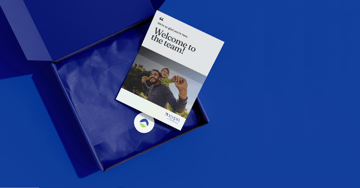The Ins and Outs of Hiring
Share this
Hiring can be one of the most intimidating things you will do as a business owner. At XY Planning Network, we firmly believe in the idea that hiring well is the most important thing a financial planner who is scaling their practice can do. Hiring the right person the first time can save you time, money, and help to provide an even better experience to your clients.
Many XY Planning Network members are hitting the point in their practices where they’re focused on hiring right now. While this is fantastic news because it means that many of you are finding success in your practice and are ready to grow to the next level, it’s also nerve-wracking. I know from experience that getting into the groove when it comes to hiring is a challenge. So many of us (myself included) have never been in a situation where we’ve needed to hire someone. So, how do you find the best candidate for your team? How do you know they’re the right fit for you?
Hiring For the Right Position
In my case, I had worked with many contractors, freelancers, or other 1099 employees who I could adjust easily depending on how successful our working relationship was. But when it came time to hire my first full-time employee? It was like I had to learn the rules to a completely different game. The first step, I’ve found, is to get clear on what position you’re hiring for. This will influence the job description you write, the places you post your job opening, the kinds of people you’ll get to apply, and the candidates you’ll select for interviews.
If you know you need help, but aren’t sure what kind of position your team needs the most, I encourage you to sit down and truly give this some thought. When in doubt, hire the person who is not only going to help you in your day-to-day job duties, but who is going to put your financial planning practice on the path to grow into the business you’re envisioning. Ask yourself: where do I want my company to be in 5-10 years, and who is going to help me get there?
Once you have a clear idea of who you want to bring onto your team, you’ll be able to clearly communicate what you’re looking for to applicants. More importantly, you’ll be able to go back to the description of the role you’re hiring for when interviewing people to help you narrow your focus on the perfect candidate.
It’s also worth mentioning here that when you’re writing a job description, list the salary. There’s no point in beating around the bush, and you would be in the wrong if you allowed a candidate to get to a point where you offered them a $45,000/year position when they were expecting $100,000/year. In many states it’s not legal to ask a candidate what kind of salary they’re expecting, or what their salary history is because it can cause discrimination against candidates who have been out of the workforce for a while, have been stuck in an underpaid position, etc.
Sourcing Great Candidates
At XY Planning Network, we do a significant portion of our hiring based on company culture fit. We have a set of values we don’t want to steer away from, and we believe they’re key to scaling the way we want. We also believe we need to have approximately 20 qualified applicants in our initial candidate pool. This is advice directly from Scaling Up by Verne Harnish. (Side note: If you’re in the hiring process right now - pick up a copy. It’s one of the best books on hiring out there.)
Finding 20 candidates who are an excellent culture fit and who are qualified is a time-consuming task, but it’s absolutely doable. The key here is to get organized early in your candidate search. After you’ve created the job description that articulates who your ideal candidate is and the role he or she will fill, set yourself up with a workflow system. I like to use Wufoo forms and plug them into job listings. I also like to create email folders or an Excel/Google sheet to track who has applied for the position or reached out for more information, as well as whether or not my team has responded to them.
In the initial job posting process, it’s incredibly important that you’re responsive - which is why a sheet to track who you’ve gotten back to can be helpful. No job applicant wants to wonder whether or not you thought their application was a good fit.
Where you post your job listing will largely depend on your location. It’s important to remember that there really isn’t a “right” answer here. Here in Montana, Indeed is really popular and we get the majority of our high-quality candidates from there. However, you could also use Monster, Glassdoor, or LinkedIn. There are also job boards on NAPFA, FPA, and the CFP Board. Some of these options are more expensive than others, so make sure you’re budgeting for the cost of job posting.
It’s also wise to keep in mind that job boards aren’t your only option - far from it, actually. One of my personal non-job board methods of sourcing candidates is to reach out to local CFP® program professors and let them know we’re hiring. Most students will want to get a job in the same area they’re going to school, and having a connection with them through their professor can help you find some excellent candidates who are genuinely interested in financial planning and other things that drew you to your area, as well.
You can also post your job opportunity on social media and tell people you know within the financial planning community that you’re looking for candidates. Networking to find your next hire can be a great way to ensure they’ve already been “vetted” by your colleagues - which will save you some of the hassle upfront of determining whether or not they are a quality candidate.
Scheduling an Initial Phone Consultation
Once you have a pool of 20 or so job applicants, it’s time for the initial phone screen. So many people skip this step, and I think it’s one of the biggest mistakes you can make. Phone screens should only take 10-15 minutes per applicant, and it’s a phenomenal way for you to immediately weed out people who don’t care or aren’t going to be a good fit. Ask questions like:
- Why are you interested in Company X?
- What would this job mean to you at this point in your career?
- What about this job is attractive to you?
- Why did you apply?
These questions will do a few things for you as the interviewer. First, they’re going to help give you an idea of whether or not the applicant has done any research on the role or your practice. Second, they’ll give you a flash of insight into the applicant’s potential personality, strengths, and values. All of these things are important factors when making a final hiring call, so it’s good to figure them out early.
Moving to Formal Interviews
Your goal should be to have 10 total applicants who, after your initial phone screen, you want to interview. Go with your gut on this one. If you feel the phone screen went well, schedule their next interview on the initial call.
This next round of interviews should be about an hour long, and they should be the more “typical” style of interview. Before you head into this interview, I recommend a personality test of some kind. At XY Planning Network, we use Strengths Finder. There are several different personality tests out there, and you can use whichever one you like best. For me, it’s not really about ruling out any one specific personality type. Instead, it’s about learning more about the applicant we’re about to interview.
A personality test will highlight a person’s work style, strengths, weaknesses, communication style, and more. I’m a big believer in all personality types working together - but some will definitely butt heads more than others. Specifically, if you see a lot of yourself in the applicant you’re interviewing and their personality test comes back as matching yours, it could be a sign of impending trouble. For example, what if you’re both stubborn or impulsive? A perfect match is not always ideal! Sometimes, it’s best to hire someone with complimentary traits for balance.
Your first hour-long interview with a candidate should be all about asking as many questions as possible. Decide on a few key questions to get to the bottom of their experience, values, what they want out of this job, how much they know about your practice (or fee structure, or style of planning), and anything else you deem important. At the end of the interview, you should always leave time for them to ask questions.
The Final Steps
After this round of hour-long interviews, you should be looking at three top candidates. Yep, only three. This will allow you to focus on these three people and truly decide who’s the exact right fit for your team rather than spreading yourself too thin and adding in too many “distraction” candidates in the interviewing process. The third and final interview should be something that’s a little bit more intensive.
Depending on the role you’re hiring for, now would also be the optimal time to ask for a work sample. The work sample should be an assignment related to a specific duty they would be expected to perform on the job. At XY Planning Network, we used to ask for a work sample with an applicant’s resume and cover letter. Now, we only ask for it from our top three candidates.
Why? Well, as it turns out, most people don’t love working for free. We found when we asked for a work sample upfront, we were actually scaring some applicants away. An applicant wants to know you’re truly considering them before they commit to hours of work. Plus, realistically you aren’t going to have time to review 20 work samples before your first round of interviews. Make it easier on everyone involved: only ask your top three candidates for a work sample.
Worth noting: it’s not ideal to simply invite them to submit a sample of work they’ve previously completed for another employer. In that scenario, there is no way to know what role your candidate played in the work. Were they a contributor or did they lead? Even if they led, it’s likely other collaborators on the project brought something to the table, making it difficult to evaluate your candidate’s abilities.
The work sample should help you decide whether someone’s work style, decision-making process, or values align with those of your practice. You could ask them to look at a sample client case and write up a recommendation. Or, you could ask them to describe how they’d respond in a specific client-facing situation. Either would be incredibly telling.
Now is also a good time to send over a copy of your employee handbook, benefits information, or any other materials you have about the company. This will help your candidates develop some good questions to ask and will hopefully offer a clear idea of the role and of your practice.
For final interviews, the format will depend on the size of your practice. For a small team or solo practice, sit down with your candidate for an hour to discuss the role and ask/answer additional questions. Work toward a conversation that leaves both you and your applicant feeling like you understand each other. If you have a larger team, schedule 2-3 hours so the applicant can chat with several team members.
During a 2-3 hour interview, start with a 1-hour interview with the applicant’s would-be direct supervisor. Plan a lunch with two or more members of the team (never just one member, because that’s a recipe for awkwardness). Finally, end with a final interview with the business owner or director. This allows the applicant to meet several people, ask a lot of valuable questions, and decide if the team is a good fit for them.
During this final interview process, you should be past the how-qualified-are-you questions. At this point, you should focus on learning who the applicants are, not what experience they have. Now is a great time to bring up how you anticipate the position evolving, how you envision this role integrating with your current team, and evaluating your applicants work samples. If something came up in their work sample or in a previous conversation that left you feeling uneasy, address it now. Allow your interviewee to do the same. Both of you should have a clear idea of whether or not this role is a good fit for that applicant by the end of the conversation.
What’s Your Superpower?
This is the question I like to save for last. It’s a tough one, and not everybody’s going to know how to respond. I look at it this way: when we’re building a team of engaged employees, it’s like we’re Professor X in X-Men. We’re seeking out candidates for our program who are exact matches for what we want. Just like the different X-Men, each candidate we interview is going to have one unique superpower. They may have several strengths - but only one quality is going to really define them.
To give you an example, my superpower is getting things started. It’s a skill I have that not everybody else does. I love to move projects out of the ideation stage and get them to launch - whether that’s hiring the right people, finding the funding, or building a process to make sure things get up and running smoothly. However, when it comes to day-to-day execution of a project, that’s our Chief Operating Officer’s superpower. Raul Dominguez constantly has at least forty projects running at once, and he manages them all seamlessly. That’s not my strength, and I’m comfortable admitting that.
Picking a Candidate
At the end of the day, you might find you’re picking between superpowers. No two candidates are going to be the same, and you might find that one will fill a very specific role while another will bring an entirely different set of skills to the table. My advice here? Take your time.
The most expensive mistake you can make is hiring the wrong person. A new hire will cost your business time, money, and valuable emotional energy. If they’re the wrong candidate they could hurt your business and harm your relationships with clients. If that doesn’t convince you to choose wisely, just think about having to start the hiring process all over again if it doesn’t work out.
Don’t feel like you have to hire anybody in this round of interviews - if nobody is really resonating with you, move on. Interview more people, and keep refining the process to get more qualified leads. Try a different method of posting your job description, or dig deeper into your network to find someone who comes recommended.
However, if you walk away from your final interview with a clear favorite, move quickly to make an offer. Remember, quality talent is in high demand!
Want Help? Join Me At Xcelerate
So many XY Planning Network members have been talking about hiring lately. I’ve seen posts in our XYPN Radio VIP Community, member forums, and other areas that are focused on expanding your RIA’s team. At XY Planning Network, we want to address the new phase that many of you are entering in your business, which is why we launched Xcelerate.
Xcelerate is our first-ever experienced members retreat in Bozeman, MT. This year, it’s happening from March 29-30 and we’ll focus on:
- Recruiting the right talent
- Developing best practices for interviews
- How to vet candidates
- Onboarding and training for new hires
- Incorporating staff members into a solo practice
And so much more! The event is for XYPN members only and registration is now open.
Don’t Forget to Celebrate
One final thought: I want to remind you that growing your firm is a big deal! Don’t forget to celebrate how far you’ve come and all of the hard work you’ve put in. Whether this is your first new team member, or your fifth, way to go!

About the Author
Alan Moore is the CEO and Co-Founder of XY Planning Network—a support ecosystem dedicated to helping fee-for-service advisors start, run, and grow their own financial planning firms and serve the clients they want. His favorite part about his job is dreaming about possibilities for what’s next, knowing his stellar team will either tell him no or Get Sh*t Done to make it happen.
Share this
- Advisor Blog (721)
- Financial Advisors (244)
- Growing an RIA (128)
- Business Development (95)
- Digital Marketing (95)
- Marketing (92)
- Community (82)
- Start an RIA (76)
- Coaching (74)
- Running an RIA (72)
- Compliance (70)
- Client Acquisition (68)
- Technology (67)
- Entrepreneurship (64)
- XYPN LIVE (64)
- Fee-only advisor (49)
- Sales (49)
- Bookkeeping (46)
- Client Engagement (45)
- Practice Management (44)
- XYPN Books (43)
- Scaling an RIA (42)
- Investment Management (41)
- Client Services (31)
- Employee Engagement (31)
- Financial Education & Resources (31)
- Lifestyle, Family, & Personal Finance (31)
- Market Trends (26)
- Journey Makers (24)
- Process (18)
- Niche (13)
- SEO (9)
- Career Change (8)
- Partnership (8)
- Transitioning Your Business (7)
- Sapphire (6)
- Persona (4)
- Transitioning To Fee-Only (4)
- Emerald (3)
- Social Media (3)
- Transitioning Clients (3)
- RIA (2)
- Onboarding (1)
Subscribe by email
You May Also Like
These Related Stories

The 5 W's of Hiring! What Would Arlene Say?
Aug 17, 2017
6 min read

4 Laws to Keep Your Hiring Compliant
May 13, 2024
6 min read




.png?width=600&height=400&name=PW%20%20Insider%20Insights%20YT%20Thumbnail%20Image%201920%20%C3%97%201080%20px%20(1).png)